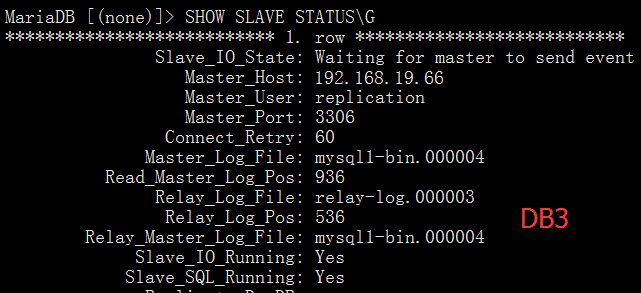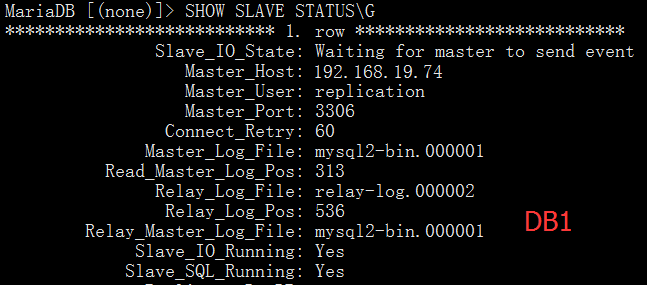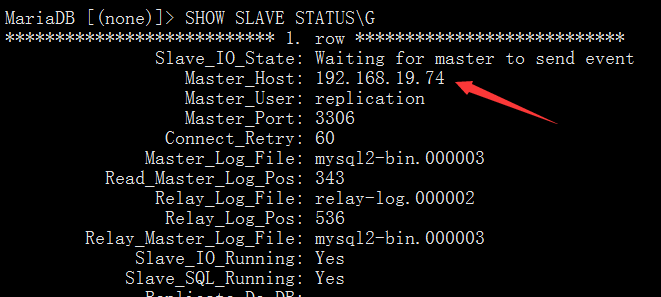mysql高可用架构之mysql-mmm配置详解
2015-08-13 07:31
796 查看
实验系统:CentOS 6.6_x86_64
实验前提:防火墙和selinux都关闭
实验说明:本实验共有5台主机,IP分配如拓扑
实验软件:mariadb-10.0.20 mysql-mmm-2.2.1 mysql-mmm-monitor-2.2.1 mysql-mmm-agent-2.2.1
下载地址:http://pan.baidu.com/s/1bnnYiMr
实验拓扑:

一、准备工作
1.根据下表,将各主机名进行修改:

2.修改hosts文件,添加如下内容:
3.规划虚拟ip,列表如下:

二、安装mariadb并配置
1.在db1-4上安装:
2.编辑配置文件:
db1:
db2:
db3:
db4:
3.在db1上创建用户:
这里需要创建三个用户,如下表:

4.查看二进制日志位置:
5.不要关闭这个mysql进程连接,避免锁失效,我们另起一个ssh连接db1服务器,进行数据库备份:
6.回到刚才mysql进程,进行解锁:
7.将database-backup.sql文件复制到其他db节点:
8.db2-4主机导入sql文件,并刷新权限:
三、设置复制
1.在db2-4上操作,将db1设置为db2-4的主:
2.查看状态:



3.查看db2的master日志位置:
4.在db1上操作,将db2设置为db1的主:

四、安装MMM
1.创建用户:
2.在mon上安装:
3.在db1-4上安装:
4.编写配置文件,五台主机必须一致:
5.在db1-4上修改mmm_agent.conf,只需要修改db1这里,是哪台就改成哪台,这里只给出db1的:
6.配置mon上的mmm_mon.conf:
五、启动测试:
1.在db1-4上启动agents:
2.在mon上启动monitor:
3.检查集群状态:

如果服务器状态不是ONLINE,可以用如下命令将服务器上线,例如:
4.从刚才图片可以看到,写请求的VIP在db1上,所有从节点也都把db1当做主节点。下面将db1停掉:
可以看到写请求的VIP已经转移到db2上了,且从节点的主都指向了db2:


5.最后开启db3、db4的只读:
到此为止,所有的配置都完成了。一个writer的VIP和四个reader的VIP都已经正常分配,大家可以创建一个远程登录账号进行测试,这里就不再给出具体的过程了。由于时间紧迫,且经验有限,配置过程中可能会出现纰漏,如有发现请及时联系我,欢迎大家的指正,谢谢! 联系QQ:82800542
实验前提:防火墙和selinux都关闭
实验说明:本实验共有5台主机,IP分配如拓扑
实验软件:mariadb-10.0.20 mysql-mmm-2.2.1 mysql-mmm-monitor-2.2.1 mysql-mmm-agent-2.2.1
下载地址:http://pan.baidu.com/s/1bnnYiMr
实验拓扑:

一、准备工作
1.根据下表,将各主机名进行修改:

2.修改hosts文件,添加如下内容:
vim /etc/hosts -------------------------------------------> 192.168.19.21 mon 192.168.19.66 db1 192.168.19.74 db2 192.168.19.76 db3 192.168.19.79 db4
3.规划虚拟ip,列表如下:

二、安装mariadb并配置
1.在db1-4上安装:
tar xf mariadb-10.0.20-linux-x86_64.tar.gz -C /usr/local/ cd /usr/local/ ln -sv mariadb-10.0.20-linux-x86_64 mysql useradd -r mysql mkdir -pv /mydata/data chown -R mysql.mysql /mydata/data/ cd mysql/ chown -R root.mysql . scripts/mysql_install_db --user=mysql --datadir=/mydata/data/ cp support-files/my-large.cnf /etc/my.cnf cp support-files/mysql.server /etc/init.d/mysqld chkconfig --add mysqld chkconfig mysqld on
2.编辑配置文件:
db1:
vim /etc/my.cnf ---------------------------------------------> [mysqld] server-id = 1 datadir = /mydata/data log-bin = /mydata/data/mysql1-bin binlog_format = ROW relay_log = /mydata/data/relay-log auto-increment-increment = 2 auto-increment-offset = 1 sync_binlog = 1 sync_master_info = 1 sync_relay_log = 1 sync_relay_log_info = 1 max_binlog_size = 100M log_slave_updates = 1 <--------------------------------------------- service mysqld start
db2:
vim /etc/my.cnf ---------------------------------------------> [mysqld] server-id = 2 datadir = /mydata/data log-bin = /mydata/data/mysql2-bin binlog_format = ROW relay_log = /mydata/data/relay-log auto-increment-increment = 2 auto-increment-offset = 2 sync_binlog = 1 sync_master_info = 1 sync_relay_log = 1 sync_relay_log_info = 1 max_binlog_size = 100M log_slave_updates = 1 <--------------------------------------------- service mysqld start
db3:
vim /etc/my.cnf ---------------------------------------------> [mysqld] server-id = 3 datadir = /mydata/data log-bin = /mydata/data/mysql3-bin binlog_format = ROW relay_log = /mydata/data/relay-log sync_binlog = 1 sync_master_info = 1 sync_relay_log = 1 sync_relay_log_info = 1 max_binlog_size = 100M log_slave_updates = 1 <--------------------------------------------- service mysqld start
db4:
vim /etc/my.cnf ---------------------------------------------> [mysqld] server-id = 4 datadir = /mydata/data log-bin = /mydata/data/mysql4-bin binlog_format = ROW relay_log = /mydata/data/relay-log sync_binlog = 1 sync_master_info = 1 sync_relay_log = 1 sync_relay_log_info = 1 max_binlog_size = 100M log_slave_updates = 1 <--------------------------------------------- service mysqld start
3.在db1上创建用户:
这里需要创建三个用户,如下表:

/usr/local/mysql/bin/mysql -------------------------------------------------> GRANT REPLICATION CLIENT ON *.* TO 'mmm_monitor'@'192.168.19.%' IDENTIFIED BY '123456'; GRANT SUPER,REPLICATION CLIENT,PROCESS ON *.* TO 'mmm_agent'@'192.168.19.%' IDENTIFIED BY '123456'; GRANT REPLICATION SLAVE ON *.* TO 'replication'@'192.168.19.%' IDENTIFIED BY '123456'
4.查看二进制日志位置:
FLUSH TABLES WITH READ LOCK; //施加锁 SHOW MASTER STATUS; +-------------------+----------+--------------+------------------+ | File | Position | Binlog_Do_DB | Binlog_Ignore_DB | +-------------------+----------+--------------+------------------+ | mysql1-bin.000004 | 936 | | | +-------------------+----------+--------------+------------------+
5.不要关闭这个mysql进程连接,避免锁失效,我们另起一个ssh连接db1服务器,进行数据库备份:
/usr/local/mysql/bin/mysqldump --all-databases > /tmp/database-backup.sql
6.回到刚才mysql进程,进行解锁:
UNLOCK TABLES;
7.将database-backup.sql文件复制到其他db节点:
scp /tmp/database-backup.sql db2:/tmp/ scp /tmp/database-backup.sql db3:/tmp/ scp /tmp/database-backup.sql db4:/tmp/
8.db2-4主机导入sql文件,并刷新权限:
/usr/local/mysql/bin/mysql < /tmp/database-backup.sql /usr/local/mysql/bin/mysql -------------------------------------------------> FLUSH PRIVILEGES;
三、设置复制
1.在db2-4上操作,将db1设置为db2-4的主:
CHANGE MASTER TO MASTER_HOST='192.168.19.66',MASTER_USER='replication',MASTER_PASSWORD='123456',MASTER_LOG_FILE='mysql1-bin.000004',MASTER_LOG_POS=936; START SLAVE;
2.查看状态:
SHOW SLAVE STATUS\G



3.查看db2的master日志位置:
SHOW MASTER STATUS; +-------------------+----------+--------------+------------------+ | File | Position | Binlog_Do_DB | Binlog_Ignore_DB | +-------------------+----------+--------------+------------------+ | mysql2-bin.000001 | 313 | | | +-------------------+----------+--------------+------------------+
4.在db1上操作,将db2设置为db1的主:
CHANGE MASTER TO MASTER_HOST='192.168.19.74',MASTER_USER='replication',MASTER_PASSWORD='123456',MASTER_LOG_FILE='mysql2-bin.000001',MASTER_LOG_POS=313; START SLAVE; SHOW SLAVE STATUS\G

四、安装MMM
1.创建用户:
useradd -s /sbin/nologin mmmd
2.在mon上安装:
yum -y install mysql-mmm-monitor
3.在db1-4上安装:
yum -y install mysql-mmm-agent
4.编写配置文件,五台主机必须一致:
vim /etc/mysql-mmm/mmm_common.conf --------------------------------------------------------> active_master_role writer <host default> cluster_interface eth0 pid_path /var/run/mysql-mmm/mmm_agentd.pid bin_path /usr/libexec/mysql-mmm/ replication_user replication //用于复制的用户 replication_password 123456 //复制用户的密码 agent_user mmm_agent //用于改变模式的用户 agent_password 123456 //改变模式用户的密码 </host> <host db1> ip 192.168.19.66 mode master peer db2 //需要监视的“同伴” </host> <host db2> ip 192.168.19.74 mode master peer db1 </host> <host db3> ip 192.168.19.76 mode slave </host> <host db4> ip 192.168.19.79 mode slave </host> <role writer> hosts db1, db2 //可写节点 ips 192.168.19.150 //写操作使用的VIP mode exclusive //排他模式,此处资源同一时间只能分配给一个主机 </role> <role reader> hosts db1, db2, db3, db4 //可读节点 ips 192.168.19.151, 192.168.19.152, 192.168.19.153, 192.168.19.154 //读操作使用的VIP mode balanced //平衡模式 </role>
5.在db1-4上修改mmm_agent.conf,只需要修改db1这里,是哪台就改成哪台,这里只给出db1的:
vim /etc/mysql-mmm/mmm_agent.conf -------------------------------------------------> include mmm_common.conf # The 'this' variable refers to this server. Proper operation requires # that 'this' server (db1 by default), as well as all other servers, have the # proper IP addresses set in mmm_common.conf. this db1 //只改这里
6.配置mon上的mmm_mon.conf:
vim /etc/mysql-mmm/mmm_mon.conf ----------------------------------------------------> include mmm_common.conf <monitor> ip 127.0.0.1 pid_path /var/run/mysql-mmm/mmm_mond.pid bin_path /usr/libexec/mysql-mmm status_path /var/lib/mysql-mmm/mmm_mond.status ping_ips 192.168.19.50, 192.168.19.66, 192.168.19.74, 192.168.19.76, 192.168.19.79 //用于测试网络可用性的IP地址,其中有一个地址能ping通,就代表网络正常,不要写入本机的ip地址 auto_set_online 60 //是否设置自动上线,如果该值大于0,抖动的主机在抖动的时间范围过后,则设置自动上线 # The kill_host_bin does not exist by default, though the monitor will # throw a warning about it missing. See the section 5.10 "Kill Host # Functionality" in the PDF documentation. # # kill_host_bin /usr/libexec/mysql-mmm/monitor/kill_host # </monitor> <host default> monitor_user mmm_monitor //用于监控的用户 monitor_password 123456 //监控用户的密码 </host> debug 0
五、启动测试:
1.在db1-4上启动agents:
chkconfig mysql-mmm-agent on service mysql-mmm-agent start
2.在mon上启动monitor:
vim /etc/default/mysql-mmm-monitor ---------------------------------------------------> ENABLED=1 <--------------------------------------------------- service mysql-mmm-monitor start
3.检查集群状态:
mmm_control show

如果服务器状态不是ONLINE,可以用如下命令将服务器上线,例如:
mmm_control set_online db1
4.从刚才图片可以看到,写请求的VIP在db1上,所有从节点也都把db1当做主节点。下面将db1停掉:
service mysqld stop //停掉db1的mysql服务
可以看到写请求的VIP已经转移到db2上了,且从节点的主都指向了db2:


5.最后开启db3、db4的只读:
vim /etc/my.cnf -------------------------------> [mysqld] read_only = 1 <------------------------------- service mysqld restart
到此为止,所有的配置都完成了。一个writer的VIP和四个reader的VIP都已经正常分配,大家可以创建一个远程登录账号进行测试,这里就不再给出具体的过程了。由于时间紧迫,且经验有限,配置过程中可能会出现纰漏,如有发现请及时联系我,欢迎大家的指正,谢谢! 联系QQ:82800542
相关文章推荐
- hadoop学习笔记之HiveSQL DDL
- PLSQLDeveloper中文显示乱码的解决方法
- 关于MySQL的TPS和QPS
- MySQL数据库ERROR 1030 (HY000): Got error 28 from storage engine
- Oracle Instant Client(即时客户端) 安装与配置 PLSQL Developer
- SqlBulkCopy批量添加数据
- pl/sql developer 编码格式设置
- SQLiteCursor和ContentProvider的线程安全问题
- MySQL server has gone away - in exactly 60 seconds
- MySQL必知必会笔记(七)安全管理 数据库维护 改善性能
- Zabbix监控mysql Master Slave主从同步(复制)状态,附脚本
- 64位win7 pl/sql developer连接linux oracle11g服务端
- 探讨Mysql中OPTIMIZE TABLE的作用详解
- mysql:Access denied; you need (at least one of) the RELOAD privilege(s) for this operation
- 一步一步跟我学习hadoop(7)----hadoop连接mysql数据库执行数据读写数据库操作
- tpcc-mysql测试mysql5.6 (xfs文件系统)
- SQL 维护计划
- win764bit系统plsqldeveloper11连接oracle11g64bit配置方法
- Linux运维 第四阶段 (五)MySQL用户和权限管理、日志管理
- SQLMap Pangolin环境搭建
